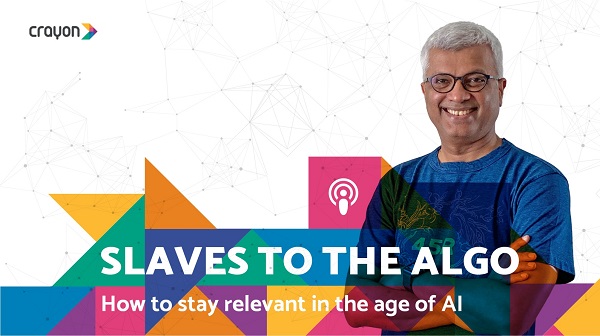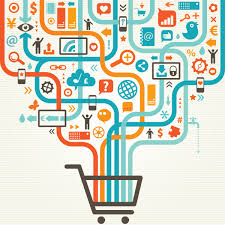Over the past several years, the retail industry has undergone a tremendous transformation. With the rapid growth of eCommerce, spearheaded by tech giants like Amazon, retail has become as much as an online experience as a physical one. And it’s spreading like wildfire across the globe.
It’s been estimated that by the end of 2019, 1.92 billion people in the world will be shopping online. That’s 25% of the global population! With such a large growing audience, shifting consumer preferences, and innovative new technology, it’s no wonder that the retail industry is in a constant state of transformation.
In order to shed some light on how much the industry has evolved, I had a conversation with Ajoy Krishnamurti, Chief Business Officer for Retail and eCommerce at Crayon Data.
Here’s how it went.

Q1. What changes impacting retail have you seen in all your years of experience?
I’ve seen how retail has changed since the pre-internet days. And it’s nothing short of staggering. The amount of information and choices available to consumers today has exploded with the internet.
One change I’ve witnessed is the immense ease which the internet brings. The increase in choices allows consumers to trade-off experience, price, and convenience. For a growing number of products, consumers can ask themselves, do I need to go out and buy this, or can I just get it delivered?
Secondly, with increased information, consumers are finding themselves overwhelmed by the sheer number of choices. They are looking for, and rewarding, personalization and curation. This could be through personalization engines online. Or even, increasingly, in-store. The challenge lies in personalizing without invading consumers’ privacy.
What’s more, with the internet and social media retail brands can amplify their presence, by reaching more consumers in ways that were unimaginable two decades ago. This is especially true for small brands.
For example, in the last 3 days, I’ve seen and clicked on brands that make bamboo water bottles, clingfilm replacements made of beeswax, not to mention at least two books that I bought – straight from links on their reviews. At the same time, brands need to be a lot more authentic.
The internet has made consumers more knowledgeable, more aware than ever before, often more than sales associates themselves, and this is changing in-store dynamics.
Q2. How much of these changes do you think have been influenced by consumer preferences?
I’ve seen consumers just starting to use the internet. And I now see them weave in and out of different digital channels in the same shopping journey. This change can actually help sort many consumer problems of traditional retail. Addressed properly, it offers an opportunity for retailers to reimagine retail around the consumers’ experience. The need to implement a new omnichannel, mobile-first strategy is a given.
There are three new fundamental changes that are happening with the consumers now:
- The greater focus on sustainability – and increasing willingness to pay a premium for products that are good for the Earth and society (such as eco-friendly products, local products with lower carbon footprint, products that are made by, or where there is a contribution to a societal cause)
- The move to healthier lifestyles (They’re buying more organic products and activewear)
- The move to experiences rather than the product; of pay per use rather than owning products (like furniture and garment rentals)
Q3. You deal with retailers on a regular basis. How have the brands you interact with reacted to the current retail + AI landscape?
Retailers are using artificial intelligence to engage with and acquire more consumers. As well as help increase conversion and ticket size, and drive cost efficiencies. I’ll explain how.
Firstly, by applying the power of personalization to users – both online and in physical stores. Secondly, to help improve consumer acquisition, retailers are shifting majorly to eCommerce portals. There are some potential use cases being explored for physical stores as well.
Third, using and analyzing data, including new data sources made available by eCommerce, to get deeper consumer insights. And put these insights to use for planning assortments. Fourth, reducing friction in the entire shopping journey, right from getting information, checking out to returns and warranties.
And finally, driving supply chain efficiencies. New technology and cloud computing are also helping retailers re-draw their tech stack to make use of them.
Q4. Several retailers have both online and offline stores that usually operate separately. Do you see retailers bridging the gap between online and offline by offering omnichannel shopping experiences? In what ways?
Do they have an option?
An online channel is table stakes today. Consumers’ expectations are sky-high – they expect to buy through any channel. And also return goods via another. They want to research products, buy online, pick up in-store, or vice versa. Buy in-store and get it delivered (especially when the product is not in stock in a store).
But one of the biggest drivers is that consumers expect to get the same degree of personalization when they visit a store, as they do online and so on.
Crayon’s maya.ai is a personalization engine – that not only supports online personalization but also works to bring the same inside the store seamlessly. By showing the best options for a consumer, regardless of whether its available in-store – or online, it truly gives her the right and relevant choices.
Q5. What do you see in the future of retail?
First and foremost, it’s important to remember that consumers are in control. Their new combined physical + digital journey is seeing the reinvention of retail.
Just as physical retail brands expand their online offerings, pure-play online retailers are doing the opposite. Companies like Warby Parker, Bonobo, Amazon & Whole foods, Lenskart in India, are getting to physical points of presence. This is shifting the purpose of the physical store – from selling to experiencing a brand complete with the metrics associated with the stores.
Technology that got started a decade back for improving consumer experience in-store will be mainstream. Think the ability to use your phone or a smart cart in-store to scan a product, get reviews and ratings, personalized recommendations. Add that with the ability to check inventory, try something out, buy, and walk out of the store with the payment already made from a stored credit card.
Parts of the journey that create the most friction for a consumer are being solved with AI. For instance, checkout is being made easy, driven by computer vision that can scan items as they are put into a basket, and paid via stored cards (Amazon Go) or full basket scans (Uniqlo).
Retailers will focus on CX instead of just trying to get consumers in and moving products.
The challenges in the new order will be to manage all of this. With adequate safeguards for consumer data and privacy.











